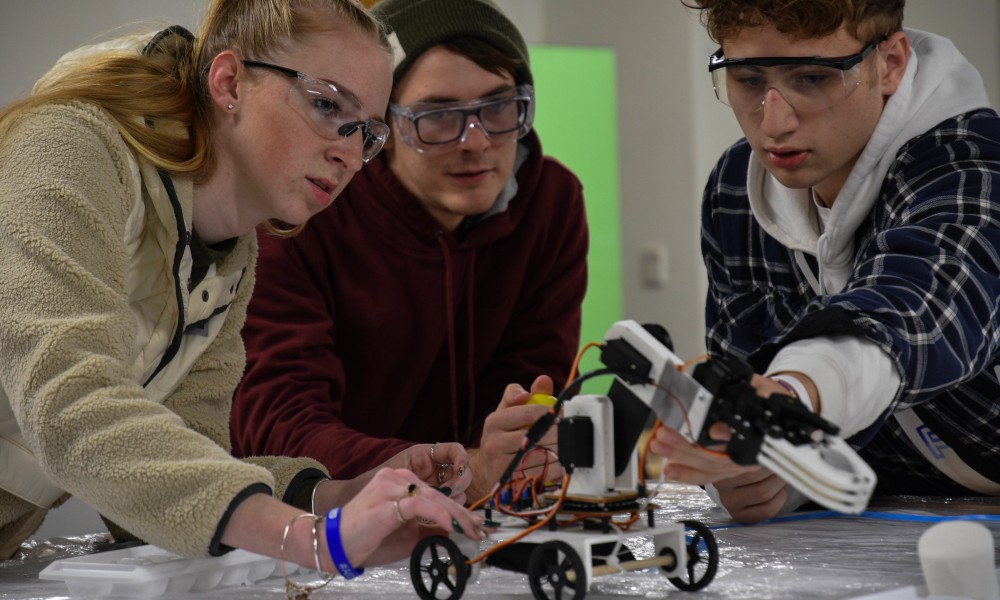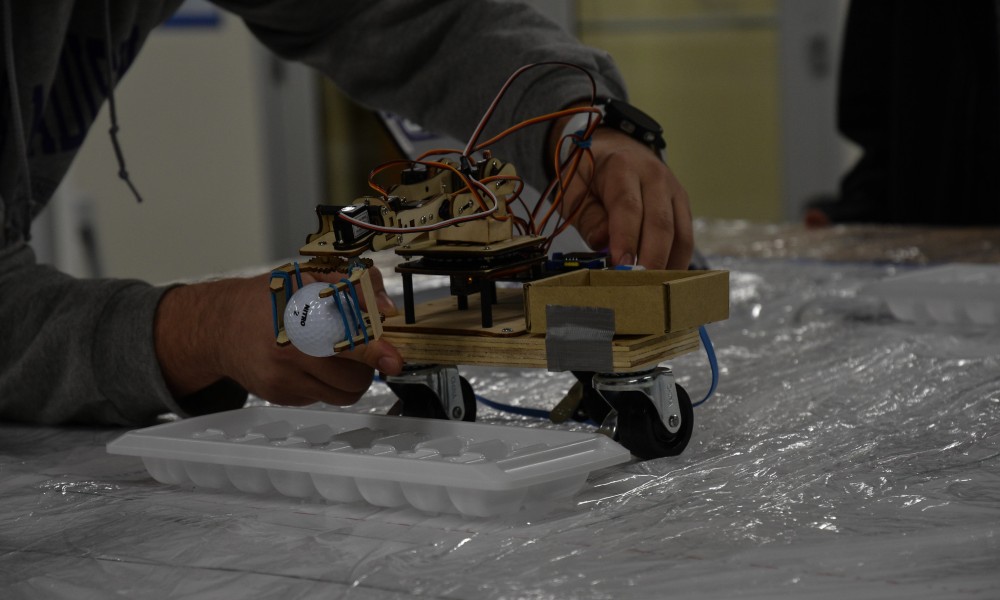Engineering students build robotic prototypes to address health care challenges
News
Second-year students in James Madison University's Engineering 231 class are collaborating on a semester-long robotic arm project under the guidance of engineering faculty Daniel Castaneda, Jason Forsyth and Kyle Gipson. The course is the first opportunity for students in the engineering program to learn the engineering design process and integrate knowledge from various disciplines, including physics, mathematics, and JMU's Engineering 112 class.
“The class is first and foremost about the engineering design process,” Castaneda said. “This is the first time the students in the engineering program take a class that really emphasizes a creative, iterative, and structured approach in developing engineering solutions.”
“It’s the first engineering class where our students see that there is a methodical rhyme and reason to how we approach engineering solution development,” Castaneda added.
In prior years, Engineering 231 and 232 were year-long, project-based courses, presenting logistical challenges amid increasing enrollment. However, in Fall 2023, Engineering 231 underwent a redesign, becoming a faster-paced, semester-long project. Students delved into the real-world issue of healthcare understaffing, explored robotics, and designed a scalable solution for at-home healthcare professionals, addressing challenges in lifting and moving medical equipment, bedding, and medically frail patients.
“The healthcare profession has had a significant understaffing of professionals who are available to care for patients, and we’ve seen other countries face that similar situation,” Castaneda said. “In those countries, they’ve used robotics as a way of augmenting support for healthcare professionals. But those robotic solutions aren’t always successful, particularly if the human element isn’t considered in the engineering solution development.”
Julia Larson, a second-year engineering major, finds that the class aligns with her career goals. “I want to become a biomedical engineer, so I want to create medical technology. This project has really helped me explore that space.”
The class is structured to emphasize engineering principles in the first half and creative, iterative, and practical solution development in the latter half.
“We started the class with regular engineering topics — the design process, mostly. And then, we were introduced to the robotic arm,” explained Larson. “It was five weeks of what we call ‘skills challenges.’ We got to develop really specific engineering skills.”
Skills challenges included following instructions and conducting tests to prepare students for their final challenge at the end of the semester. Students worked in small teams using robotic kits to build small-scale robotic arm prototypes and explore moment and torque, a type of force that causes rotation and twist.
In the final five weeks of the class, students were challenged to work in teams and create an engineering prototype that could assist at-home care professionals with difficult tasks. Students learned the challenges of navigating time constraints when exploring different ideas, deciding whether to take a more lenient or literal approach and troubleshooting technical challenges caused by the five-week time limit.
“We are looking at small-scale prototyping,” Larson says. “Our project has been scaled down to lifting an egg, a marshmallow, and a golf ball – the egg represents a medically frail patient, the marshmallow represents a mattress, and the golf represents heavy medical equipment.”

Castaneda finds this fast-paced environment to be a positive challenge for his students. “I’ve seen students really embracing this open-ended project with a lot of curiosity and a lot of willingness to build on what they’ve learned earlier in the class to make this thing work by December,” Castaneda said.
This is Castaneda’s first time teaching the class. He enjoys seeing excitement grow in his students as the class nears the end, and he notes students’ realization of how the topics of Engineering 231 link to their other courses. “It’s wonderful to see how students realize the value of mathematics and physics in engineering design. Engineers mustn’t tinker — we must design — and we do that with a lot of math and physics,” Castaneda said.
Larson shares that her biggest takeaway from the class is improved collaboration skills, learning to consider others’ opinions, and recognizing the applicability of knowledge from physics and math. “Learning about torque in engineering has helped me to better understand it in physics,” she said.
Reflecting on her experience, Larson appreciates the support provided in this project, emphasizing a sense of collaboration and encouragement. “I have more trust in the abilities of my peers,” Larson said. “We’re encouraged to think about our strengths and weaknesses and share them with our team.”
As the semester concludes, students like Larson find value in the class's supportive environment, where they feel guided each step of the way.
“We’re excited to see the students tackle their next project, Engineering 232, next semester,” Castaneda said. “We’ve got an even bigger semester-long challenge planned for our students!”
